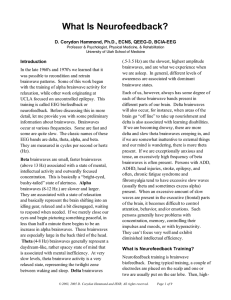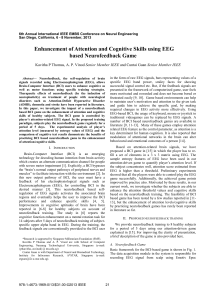XV - Thomas M. Brod MD, Services in self
advertisement
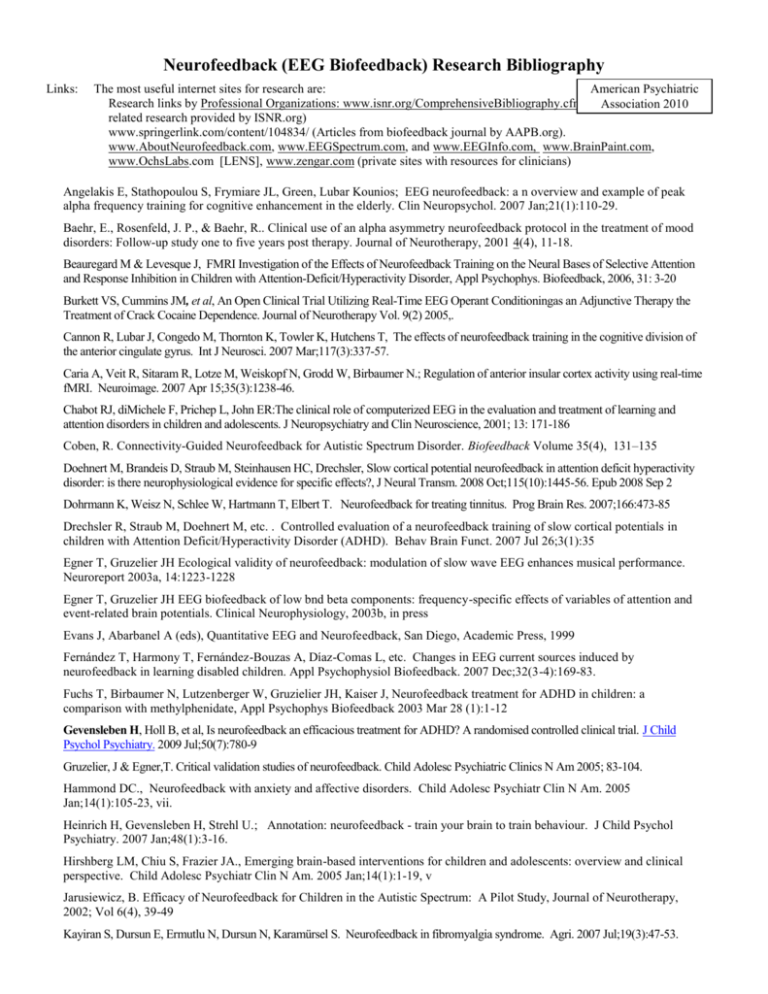
Neurofeedback (EEG Biofeedback) Research Bibliography Links: American Psychiatric The most useful internet sites for research are: Research links by Professional Organizations: www.isnr.org/ComprehensiveBibliography.cfm (Comprehensive list of Association 2010 related research provided by ISNR.org) www.springerlink.com/content/104834/ (Articles from biofeedback journal by AAPB.org). www.AboutNeurofeedback.com, www.EEGSpectrum.com, and www.EEGInfo.com, www.BrainPaint.com, www.OchsLabs.com [LENS], www.zengar.com (private sites with resources for clinicians) Angelakis E, Stathopoulou S, Frymiare JL, Green, Lubar Kounios; EEG neurofeedback: a n overview and example of peak alpha frequency training for cognitive enhancement in the elderly. Clin Neuropsychol. 2007 Jan;21(1):110-29. Baehr, E., Rosenfeld, J. P., & Baehr, R.. Clinical use of an alpha asymmetry neurofeedback protocol in the treatment of mood disorders: Follow-up study one to five years post therapy. Journal of Neurotherapy, 2001 4(4), 11-18. Beauregard M & Levesque J, FMRI Investigation of the Effects of Neurofeedback Training on the Neural Bases of Selective Attention and Response Inhibition in Children with Attention-Deficit/Hyperactivity Disorder, Appl Psychophys. Biofeedback, 2006, 31: 3-20 Burkett VS, Cummins JM, et al, An Open Clinical Trial Utilizing Real-Time EEG Operant Conditioningas an Adjunctive Therapy the Treatment of Crack Cocaine Dependence. Journal of Neurotherapy Vol. 9(2) 2005,. Cannon R, Lubar J, Congedo M, Thornton K, Towler K, Hutchens T, The effects of neurofeedback training in the cognitive division of the anterior cingulate gyrus. Int J Neurosci. 2007 Mar;117(3):337-57. Caria A, Veit R, Sitaram R, Lotze M, Weiskopf N, Grodd W, Birbaumer N.; Regulation of anterior insular cortex activity using real-time fMRI. Neuroimage. 2007 Apr 15;35(3):1238-46. Chabot RJ, diMichele F, Prichep L, John ER:The clinical role of computerized EEG in the evaluation and treatment of learning and attention disorders in children and adolescents. J Neuropsychiatry and Clin Neuroscience, 2001; 13: 171-186 Coben, R. Connectivity-Guided Neurofeedback for Autistic Spectrum Disorder. Biofeedback Volume 35(4), 131–135 Doehnert M, Brandeis D, Straub M, Steinhausen HC, Drechsler, Slow cortical potential neurofeedback in attention deficit hyperactivity disorder: is there neurophysiological evidence for specific effects?, J Neural Transm. 2008 Oct;115(10):1445-56. Epub 2008 Sep 2 Dohrmann K, Weisz N, Schlee W, Hartmann T, Elbert T. Neurofeedback for treating tinnitus. Prog Brain Res. 2007;166:473-85 Drechsler R, Straub M, Doehnert M, etc. . Controlled evaluation of a neurofeedback training of slow cortical potentials in children with Attention Deficit/Hyperactivity Disorder (ADHD). Behav Brain Funct. 2007 Jul 26;3(1):35 Egner T, Gruzelier JH Ecological validity of neurofeedback: modulation of slow wave EEG enhances musical performance. Neuroreport 2003a, 14:1223-1228 Egner T, Gruzelier JH EEG biofeedback of low bnd beta components: frequency-specific effects of variables of attention and event-related brain potentials. Clinical Neurophysiology, 2003b, in press Evans J, Abarbanel A (eds), Quantitative EEG and Neurofeedback, San Diego, Academic Press, 1999 Fernández T, Harmony T, Fernández-Bouzas A, Díaz-Comas L, etc. Changes in EEG current sources induced by neurofeedback in learning disabled children. Appl Psychophysiol Biofeedback. 2007 Dec;32(3-4):169-83. Fuchs T, Birbaumer N, Lutzenberger W, Gruzielier JH, Kaiser J, Neurofeedback treatment for ADHD in children: a comparison with methylphenidate, Appl Psychophys Biofeedback 2003 Mar 28 (1):1-12 Gevensleben H, Holl B, et al, Is neurofeedback an efficacious treatment for ADHD? A randomised controlled clinical trial. J Child Psychol Psychiatry. 2009 Jul;50(7):780-9 Gruzelier, J & Egner,T. Critical validation studies of neurofeedback. Child Adolesc Psychiatric Clinics N Am 2005; 83-104. Hammond DC., Neurofeedback with anxiety and affective disorders. Child Adolesc Psychiatr Clin N Am. 2005 Jan;14(1):105-23, vii. Heinrich H, Gevensleben H, Strehl U.; Annotation: neurofeedback - train your brain to train behaviour. J Child Psychol Psychiatry. 2007 Jan;48(1):3-16. Hirshberg LM, Chiu S, Frazier JA., Emerging brain-based interventions for children and adolescents: overview and clinical perspective. Child Adolesc Psychiatr Clin N Am. 2005 Jan;14(1):1-19, v Jarusiewicz, B. Efficacy of Neurofeedback for Children in the Autistic Spectrum: A Pilot Study, Journal of Neurotherapy, 2002; Vol 6(4), 39-49 Kayiran S, Dursun E, Ermutlu N, Dursun N, Karamürsel S. Neurofeedback in fibromyalgia syndrome. Agri. 2007 Jul;19(3):47-53. Kaiser DA, Othmer S: Effect of Neurofeedback on variables of attention in a large multi-center trial. Journal of Neurotherapy, 2000 4(1), 5-15. Lantz D, & Sterman MB: Neuropsychological assessment of subjects with uncontrolled epilepsy: Effects of EEG biofeedback training. Epilepsia, 1988; 29(2), 163-171. Leins U, Goth G, Hinterberger T, Klinger C, Rumpf N, Strehl U; Neurofeedback for Children with ADHD: A Comparison of SCP and Theta/Beta Protocols. Appl Psychophysiol Biofeedback. 2007 Jun;32(2):73-88. Levesque J, Beauregard M, Mensour B, Effect of neurofeedback training on the neuronal substrates of selective attention in children with attention-deficit/hyperactivity disorder: A functional magnetic resonance imaging study. Neuroscience Letters (2006) 216-221 Loo SK, Barkley RA: Clinical Utility of EEG in ADHD. Applied Neuropsychology 2005, Vol. 12, 64-76 Lubar JF: Neocortical Dynamics: implications for understanding the role of neurofeedback and related techniques for the enhancement of attention. Applied Psychophysiology and Biofedback, 1997 22: 111-25. Lubar JF and Lubar JO: Neurofeedback assessment and treatment for attention deficit/hyperactivity disorders. in Evans JR and Abarbanel A (eds): Introduction to Quantitative EEG and Neurofeedback Academic Press 1999 Lutz A, Greischar LL, Rawlings NB, Ricard M, Davidson R. Longterm meditators self-induce high amplitude gamma synchrony during mental practice. Proc Natl Acad Sci USA 2004; 101:16369-73. Masterpasqua, F; Healey, KN Neurofeedback in Psychological Practice; Professional Psychology: Research & Practice, 2003; Vol 34(6), Dec. pp. 652-656 Monastra VJ, Electroencephalographic biofeedback (neurotherapy) as a treatment for attention deficit hyperactivity disorder: rationale and empirical foundation. Child Adolesc Psychiatr Clin N Am. 2005 Jan;14(1):55-82, vi. Monastra VJ., Monastra DM., & George,S. . The effects of stimulant therapy, EEG biofeedback, and parenting style on the primary symptoms of ADHD. Applied Psychophysiology & Biofeedback, 2002, 27(4), 231-249. Nash JK, Treatment of ADHD with neurotherapy. Clinical Electroencephalography 2000, 31(1), 30-37 Paquette V, Beauregard M, Beaulieu-Prévost D. Effect of a psychoneurotherapy on brain electromagnetic tomography in individuals with major depressive disorder. Psychiatry Res. 2009 Dec 30;174(3):231-9. Epub 2009 Nov 13. Peniston EG, Marrinan DA, Deming WA, and Kulkosky PJ: EEG alpha-theta brainwave synchronization in Vietnam veterans with combat-related post-traumatic stress disorder and alcohol abuse. Adv Med Psychotherapy 1993 6: 37-30 Pineda J, Brang D, Hecht , E., Edwards, L., Carey, Bacon, Futagaki, Suk, Birnbaum and Rork. Positive behavioral and electrophysiological changes following neurofeedback training in children with autism. Research In Autism Spectrum Disorders Volume 2, Issue 3, July-September 2008, Pages 557-581 Rosenfeld JP: An EEG Biofeedback Protocol for Affective Disorders. Clin Electroencephalography 2000:7-12 Rossiter, T.R., & La Vaque, T.J. A comparison of EEG biofeedback and psychostimulants in treating attention deficit/hyperactivity disorder. Journal of Neurotherapy, . 1995; 1, 48-59 Scott W, Kaiser D. Sideroff S, et al, Reduction in substance abuse recidivism when neurofeedback is a component of treatment. A J Alcohol Drug Abuse , 31:3, 455-469,2005 Sterman MB: Physiological origins and functional correlates of EEG rhythmic activities: implications for self-regulation. Biofeedback and Self-Regulation 1996 21:3-34 Strehl U, Leins U, Goth G, Klinger C, Hinterberger T, Birbaumer N. Self-regulation of slow cortical potentials: a new treatment for children with attention-deficit/hyperactivity disorder. Pediatrics. 2006 Nov;118(5):e1530-40. Tinius TP, Tinius KA: Changes after EEG biofeedback and cognitive retraining in adults with mild traumatic brain injury and attention deficit disorder. Journal of Neurotherapy, 2001; 4(2), 27-44. Thornton, K.E., & Carmody. D. P. (2008). Efficacy of Traumatic Brain Injury Rehabilitation: Interventions of QEEG-guided Biofeedback, Computers, Strategies, and Medications. Appl Psychophysiol Biofeedback 33:101–124 Uhlmann C, Froscher W. Biofeedback treatment in patients with refractory epilepsy: Changes in depression and control orientation. Seizure 2001, 10(1), 34-38. Vernon D, Egner T, Cooper N, Compton T, Neilands C, Sheri A, Gruzielier J, The effect of training distinct neurofeedback protocols on aspects of cognitive performance. Intl J Psychophys, 2003, 47: 75-86 Walker JE, Kozlowski GP, Neurofeedback treatment of epilepsy. Child Adolesc Psychiatr Clin N Am. 2005 Jan;14 (1):163-76, viii. Yucha, C., & Montgomery, D. (2008). Evidence-Based Practice in Biofeedback and Neurofeedback. Association for Applied Psychophysiology and Biofeedback. www.aapb.org

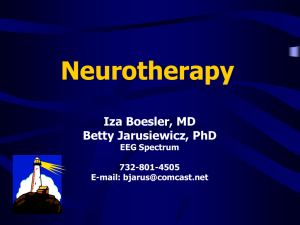
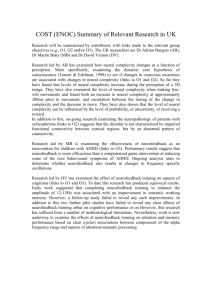
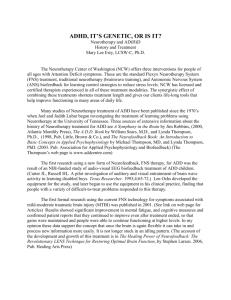
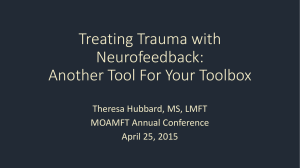
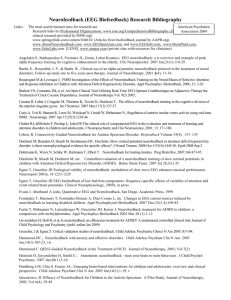
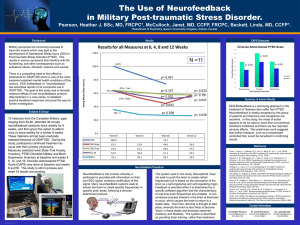
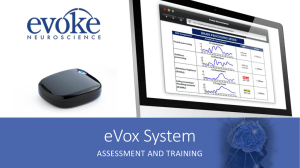
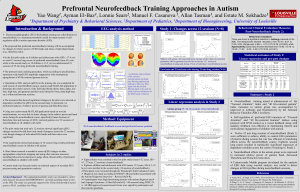
![P1: IKF Applied Psychophysiology and Biofeedback [apb] pp681-apbi-453896 January 10, 2003](http://s2.studylib.net/store/data/011620184_1-d076691c272ac695b0355691f506d7db-300x300.png)
